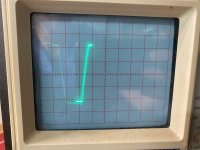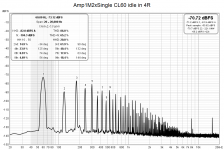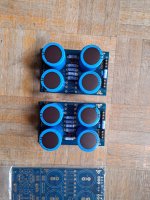I feel I am going down a rabbit hole, however, it is interesting and fun. Have a couple M2x amps and both are using the universal PSU. The M2x Edcors are known to pick up noise from the power tranny, however in my limited experience, the spectrum seems to be more than just mains pickup. The harmonics look like that of a square wave. When I look at the waveforms of the primary and secondary of the transformer I see the following: The primary does show a bit of a clip, however, the secondary waveform is highly clipped and nearly a square wave. The transformer is ANTEC 400VA 2x18 4218. CRC filtration with 240uF capacitance. Shouldn't even be close to the transformer rating.


Forgive the pics of scope. My digital one has finally bit it. won't boot anymore.
.
And yes I can hear a faint hum on this amp if close enough.


Forgive the pics of scope. My digital one has finally bit it. won't boot anymore.
.

And yes I can hear a faint hum on this amp if close enough.
Thanks. Not sure if I am up a wrong tree or not though. The M2x sounds really good even with this on the spectrum.. Sometimes its best not to look :-> This may be one of those times
I always insert shorting plugs into both RCA input jacks when measuring noise. It gives me greater confidence that the oscilloscope waveform I see when probing across the Edcor transformer primary, is created within the amplifier itself.
And of course with the input shorted, the input signal is zero volts. So there's zero signal across the Edcor transformer primary, and zero signal across the Edcor transformer secondary. Not a clipped sine wave -- a flatline.
And of course with the input shorted, the input signal is zero volts. So there's zero signal across the Edcor transformer primary, and zero signal across the Edcor transformer secondary. Not a clipped sine wave -- a flatline.
in the guide you strongly advice to keep the 2 sides together. as i am building mono blocks i detached them. can it work like that ? and if yes where is the V- on the left one and V + on the left ? where is the ground ?
thanks
thanks
Please explain why building mono blocks nescessitates detaching the boards.
The only reasonable explanation I can see is running an amp not using a bipolar psu.
Other than that, keeping them together or very close is the only logical solution.
In a bipolar PSU audio gnd is made where the neg rail of the positive half of the psu meets the positive rail of the negative half of the psu, establishing PSU 0V. (pos-minus=0V.
The only reasonable explanation I can see is running an amp not using a bipolar psu.
Other than that, keeping them together or very close is the only logical solution.
In a bipolar PSU audio gnd is made where the neg rail of the positive half of the psu meets the positive rail of the negative half of the psu, establishing PSU 0V. (pos-minus=0V.
Last edited:
To add to Andynor’s answer:as i am building mono blocks i detached them. can it work like that ?
For a dual mono (firstwatt-clone), you need 1 complete board, detached or not…
ok... i got two boxes, two transfo in mono... i cannot go backwards...
but i will have two psu boards soon.
in this case you have 8 capacitors for one channel ?
and you leave one channel without connections ?
why make this board detachable if it is meant to stay together ?
but i will have two psu boards soon.
in this case you have 8 capacitors for one channel ?
and you leave one channel without connections ?
why make this board detachable if it is meant to stay together ?
Take a picture or draw out what you are thinking. From what I understand, you want to take the dual-rail power supply and split it into two single-rail power supplies. Assuming that is what your amp design calls for, you should be fine.
well it s rather simple: i want to make an Aleph J in mono block with one 18V secondary per transfo.
i thought the PSU board was symetrical 4 capacitors per channel. and that i could simply split the boards...
i thought the PSU board was symetrical 4 capacitors per channel. and that i could simply split the boards...
For an aleph, you need a +0- psu, as you get by building this complete PSU.
Consider each channel a complete amplifier (and so, a stereo-amplifier a set of 2 complete amplifiers, with eventually 2 PSUs or with a shared — +0- — PSU).
Wether you connect one or two amps to the PSU is a matter of quality-expectation.
Since the universal PSU is made to accomodate as many possibilities as … possible 😀, you can split it in two:
For a single-rail concept (you build only a half) or for a constrained space (you build and connect both halves ).
Dual-mono = 1 complete PSU per channel
Consider each channel a complete amplifier (and so, a stereo-amplifier a set of 2 complete amplifiers, with eventually 2 PSUs or with a shared — +0- — PSU).
Wether you connect one or two amps to the PSU is a matter of quality-expectation.
Since the universal PSU is made to accomodate as many possibilities as … possible 😀, you can split it in two:
For a single-rail concept (you build only a half) or for a constrained space (you build and connect both halves ).
Dual-mono = 1 complete PSU per channel
Generally speaking mono blocks can be build single-ended and differential as well. Might be that I've missed it, but be precise which type of mono blocks are you building, so we all talk about the same. A differential mono block has basically two channels and two (bipolar) PSUs in there, a single-ended mono block has one channel and one PSU. For me, a mono block is highest-end and thus always differential, for somebody else, not necessary.
Last edited:
thanks for your help sincerly... but the answers exceed my understanding in electronics allready.
let's say i have two chassis, and two transfo 400VA 1*18V
I wan t to install each board of the Aleph J in these separate chassis.
Then i have to use A COMPLETE PSU BOARD (as in with both side linked) PER CHASSIS ? it will feed only one aleph J board instead of two but that s fine.
i am correct ?
so sorry i got into this dispite my will and i am just trying to get out 🙂
let's say i have two chassis, and two transfo 400VA 1*18V
I wan t to install each board of the Aleph J in these separate chassis.
Then i have to use A COMPLETE PSU BOARD (as in with both side linked) PER CHASSIS ? it will feed only one aleph J board instead of two but that s fine.
i am correct ?
so sorry i got into this dispite my will and i am just trying to get out 🙂
Ok, looks like you are building single-ended mono blocks. In this case each chassis houses one channel, one PSU and one transformer. The PSUs for this type of amps are bipolar, this means they consist of two identical halves, so you can get + and - output in addition to ground. Now, these positive and negative halves can be physically on a single board or on separate boards. How does your PSU board look like, have an image?
Last edited:
^ Yes. You are describing monoblocks correctly. 1 channel per chassis. Each chassis has its own transformer => its own power supply.
Yes, you must have a complete PSU board per chassis. It is okay if you separated the boards. It will still work properly.
One half of the board is for the V+ and the other half of the board is for the V-. You will see this called a 'dual rail' power supply. In the schematics for the Aleph J, you will see +24V and -24V.
I think this is a wonderful guide to building the Aleph J. It does not cover monoblocks, but it will still cover the vast majority of what you need. Build two of the PSUs as noted in this blog. Ask more if you have questions.
Edited Note - Are you certain that your transformers are 1x18V secondary? That could complicate things.
https://diyalephj.blogspot.com/2020/07/introduction-what-is-this-and-who-is-it.html
Yes, you must have a complete PSU board per chassis. It is okay if you separated the boards. It will still work properly.
One half of the board is for the V+ and the other half of the board is for the V-. You will see this called a 'dual rail' power supply. In the schematics for the Aleph J, you will see +24V and -24V.
I think this is a wonderful guide to building the Aleph J. It does not cover monoblocks, but it will still cover the vast majority of what you need. Build two of the PSUs as noted in this blog. Ask more if you have questions.
Edited Note - Are you certain that your transformers are 1x18V secondary? That could complicate things.
https://diyalephj.blogspot.com/2020/07/introduction-what-is-this-and-who-is-it.html
Last edited:
You would need both boards per chassis (and in your case channel as you do mono blocks). Both boards would form ONE bi-polar PSU.
One board outputs the +VDC, the second one the -VDC output.
Here is the schematics.
Yes you need two secondaries per transformer for a bi-polar PSU, each one as input for each of these boards above.
Or two (identical) transformers if they only have one secondary.
One board outputs the +VDC, the second one the -VDC output.
Here is the schematics.
Yes you need two secondaries per transformer for a bi-polar PSU, each one as input for each of these boards above.
Or two (identical) transformers if they only have one secondary.
Last edited:
My Aleph J build is dual mono, although both amplifier channels are in the same case. You could certainly run them in separate cases if you prefer. But as noted, you need two of everything, one for each channel. I have two power supplies (both sides), two transformers, two amp board sets, etc. If you'd like to take a look to get the idea, here's a link to my completed project. And yes, 2x18V transformers are preferred (in its simplest implementation). You could use the 1x18V transformers, one for each rail. But they physically take up a fair bit of space. So I opted for the 2x18s.
https://www.diyaudio.com/community/threads/new-aleph-j-builder-from-wisconsin-usa.368029/
Edit: Completed dual power supply is Post #139 and mains input wiring is Post #165
https://www.diyaudio.com/community/threads/new-aleph-j-builder-from-wisconsin-usa.368029/
Edit: Completed dual power supply is Post #139 and mains input wiring is Post #165
Last edited:
- Home
- Amplifiers
- Power Supplies
- diyAudio Power Supply Circuit Board v3 illustrated build guide
